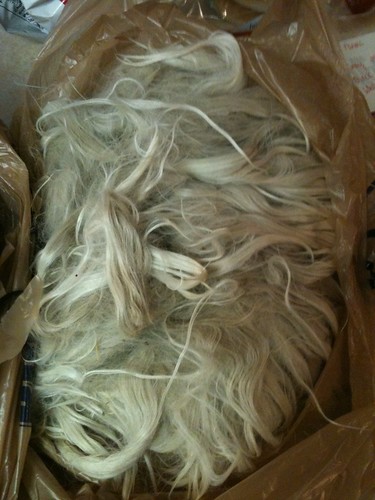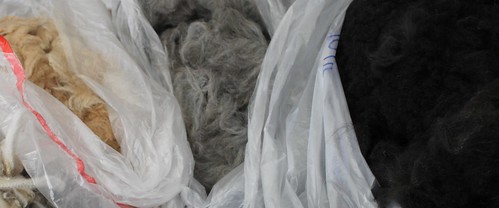Seeing as how its fiber festival season this seems like an appropriate topic. For simplicity sake I’m defining raw fleece as something cut off the animal and sold as is. It’s not been washed, picked or cleaned. Seriously, they shear it off and stick it in a trash bag.
You will find raw fleeces at most fiber festivals. You may also know of or hear of vendors in your area that will sell fleeces. In the Midwest we tend to have a lot of options for Alpaca fleeces. I can always find some at spring fiber festivals (fleeces are more common in the spring as that’s when they shear) and there are several alpaca farms in the area. Vendors typically sell a fleece in two parts – the blanket and seconds. The blanket is off the main body of the animal and the seconds are shorter cut from other areas. The seconds are usable but not as highly desired. I typically buy just the blanket if I can.
There are two types of Alpaca – Huacaya and Suri. Suri is in long, silky, curly locks, much like mohair. When you buy commercial line it is most likely Huacaya unless the label says Suri. Huacaya is shorter, frequently has a bit of crimp and is more “fur like.” I love both but generally use Huacaya as its more versatile and easier to work with. I suggest you try some of both. Below is a picture of a pound of Suri fiber.
Once I find an alpaca vendor I start looking at the fleeces. They’re typically stored in large clear plastics trash bags. You should be allowed to feel around in the bag (if not, that’s a warning sign) and look to see the color. I pull out a lock of the fleece and hold it between my fingers to see the staple length and crimp. Crimp will vary but there should be some, just like with wool. The staple length will range from 3 to 6 inches, with most being about 4 inches. Of course, a big part will be your judgment as to how soft the fiber is.
Next I root around in the bag a bit. Are most of the fibers the same length? How much veg matter (tree pieces, straw, hay, burs) is in the fleece? Is the color what you want? A note on color – there are 22 separate colors of alpaca. Generally though you have white, fawn (brown) of some shade, gray and black. True black is less common to find but possible.
If you’re satisfied with the fleece, go ahead and purchase it. Because alpaca fleeces are smaller (one to three pounds of blanket), they’re generally sold whole and not by the pound. The exception is Suri Alapca which is usually sold by the pound. Price-wise there’s a lot of variation depending on when the animal was sheared, the quality of the fiber and the vendor. I purchase three Huacaya fleeces recently: 2.6 pounds of black (2014 blanket) for $45, 1.8 pounds of gray (2013 blanket) for $20 and 1.2 pounds of fawn (2013 blanket) for $15.
I learned something at the last fiber festival – once you’ve bought your fleece do NOT tie the bag closed. The alpaca vendor said this can trap moisture as you go from one environment to another (i.e. from the cool, dry fairground building to your hot, humid car) and cause moisture problems. In other words, let it breath.
Soon I’ll post about what to do with that alpaca fleece once you’ve got it home. We’ll need a nice spring day for that!




Very Informative. Thank you
Glad to hear. Thank you for reading!